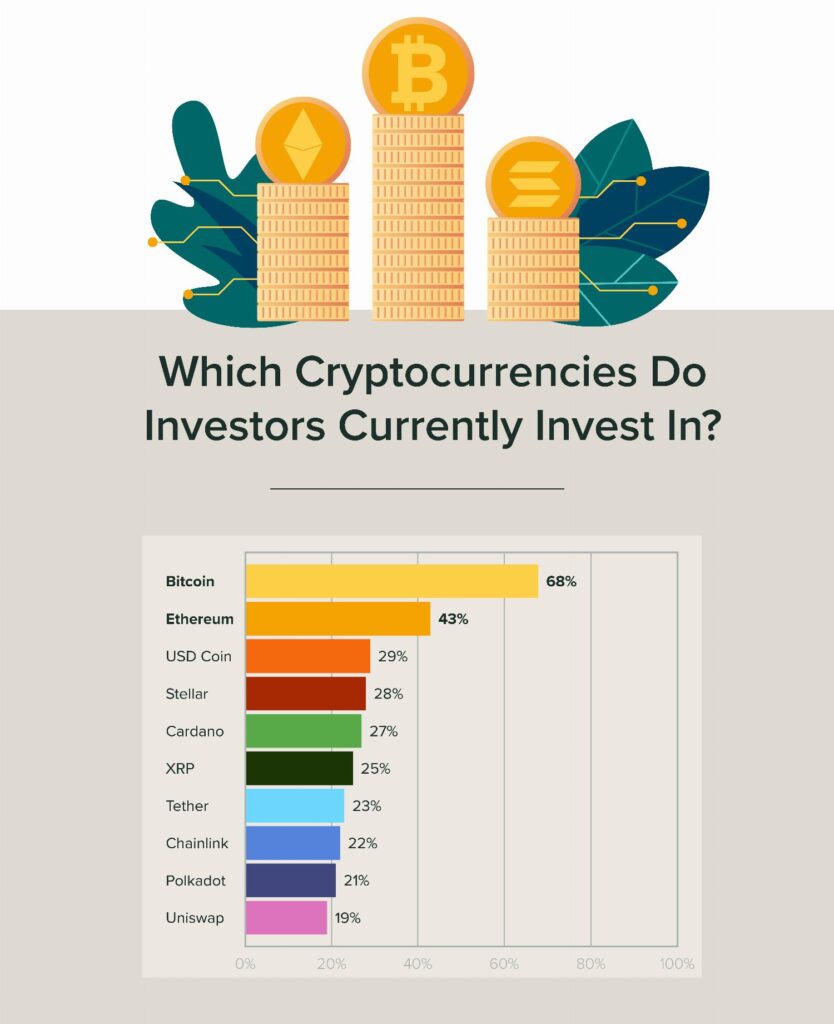
Though cryptocurrency has risen and fallen over the years, the digital asset still regularly dominates news headlines - and investors have taken note.
To better understand seasoned cryptocurrency investors' knowledge, habits, and concerns, we asked a group of 600 crypto investors, ages 16 and older, to tell us all about their investing habits, sentiments, how they learn about cryptocurrency, and more.
Of those interviewed, 57% were men and 43% were women. We surveyed individuals whose ages fell into the following categories and percentages:
- 16-17: 1.67%
- 18-24: 20.83%
- 25-34: 26.33%
- 35-44: 31.17%
- 45-54: 11%
- 55 and older: 9%
The results helped us uncover crypto investing trends and habits and how they differ by generation (Gen Z, Millennials, Gen X, and Baby Boomers). As you can see, Millennials are the most active in crypto investing, based on our research and research by the crypto exchange Gemini.
Do your cryptocurrency investing habits match up to those included in our generational survey? Keep reading to learn more about the cryptocurrency investing insights we uncovered.
1. Bitcoin Is the Go-To Leader in the Crypto Space

We asked participants which type of coin comes to mind first when they think of cryptocurrency. Participants overwhelmingly responded "Bitcoin," at a 60% response rate.
Although this isn't surprising, it does tell us about the current state of crypto and the perception of other types of cryptocurrencies.
Bitcoin, a currency invented in 2009 by an unknown person using the alias Satoshi Nakamoto, allows transactions to occur without being tied to any country or being subject to regulation. More than a decade later, it remains the most well-known and highly priced cryptocurrency in the world.
Some key factors make Bitcoin one of the most popular cryptocurrencies in a growing sea of crypto assets:
- Users can easily transfer Bitcoin from one digital wallet to another digital wallet.
- Bitcoin carries a high price; experts predict a $120,000 bitcoin price by the end of 2021, $300,000 at the end of 2025, and $500,000 in 2030.
- Mainstream companies often accept Bitcoin as payment.
- Investors have noted that Bitcoin has the highest market capitalization among cryptocurrencies, which can indicate less risk.
Of those surveyed, Ethereum came to mind next, at a low 7.50%.
2. Bitcoin and Ethereum Are the Most Popular Cryptocurrencies Participants Invest In
One of our key questions asked which types of cryptocurrencies participants invest in, and Ethereum earned the silver, while Bitcoin overwhelmingly won gold across all generations surveyed.

Which cryptocurrencies do investors currently invest in?
- Bitcoin: 67.67%
- Ethereum: 43.33%
- USD Coin: 29.33%
- Stellar: 27.83%
- Cardano: 26.83%
- XRP: 24.50%
- Tether: 22.67%
- Chainlink: 22.33%
- Polkadot: 20.50%
- Uniswap: 18.83%
Ethereum is a decentralized, open-source blockchain with smart contract functionality. It's associated with the cryptocurrency called ether (ETH). After Bitcoin, it's the largest cryptocurrency by market capitalization.

Which cryptocurrency do investors believe provides the best investment opportunity?
- Bitcoin: 46.33%
- Ethereum: 18.5%
- USD Coin: 6.5%
- Stellar: 5.5%
- XRP: 5.33%
- Cardano: 5%
- Chainlink: 4.67%
- Uniswap: 3%
- Polkadot: 2.83%
- Tether: 2.33%
Participants also feel Bitcoin (46.33%) provides the best investment opportunity among all cryptocurrencies, followed by Ethereum (18.5%).
Bitcoin has been around longer than Ethereum, which may contribute to its greater name recognition and performance. Bitcoin was first released on January 3, 2009, while Ethereum's live blockchain was initially launched on July 30, 2015.
3. Investing for the Future Is a Primary Motivation of Investing in Crypto

Why do investors invest in cryptocurrency?
- Long-term investing: 60.5%
- Active trading: 42.67%
- Purchasing online goods and services: 36.67%
- Purchasing in-person goods and services: 27.67%
- Increased privacy of transactions: 27.17%
- Paying tuition: 22.67%
- Donating to charities: 19.17%
- Other: 9%
We asked why investors buy crypto, and most responded that they did so for long-term investment purposes, such as retirement.
Social media may even play into some of the reasons that cryptocurrency investors tend to hold on for the long term.
For example, the crypto term "HODL," which has turned into a cryptocurrency meme, stands for "hold onto dear life" - in other words, to hold the cryptocurrency, particularly when it becomes volatile.
In addition to long-term investing, those who invest in cryptocurrency also favor it for other reasons, namely for active trading (42.67%), purchasing online goods and services (36.67%), and purchasing in-person goods and services, such as at brick-and-mortar retailers (27.67%).
4. Younger Generations Are More Familiar With "Obscure" Cryptocurrencies

Younger generations prove to know their obscure cryptocurrencies like Dogecoin, IOTA, and Komodo.
For example, we asked participants which of the following "obscure" cryptocurrencies they have heard of, and these top three showed up in the results first:
- Dogecoin: 60.67%
- Komodo: 29.67%
- Monero: 31.33%
Larger percentages of Gen Z, Millennials, and Gen X participants have heard of these cryptocurrencies compared to Baby Boomers. For Dogecoin in particular, 48.8% of Gen Z has heard of it, 60.67% of Millennials, and 64.82% of Gen Xers, compared to just 44.44% of Baby Boomers.
Elon Musk and Mark Cuban exerted influence on Dogecoin in May 2021, which may have contributed to the coin's notoriety. The Shiba Inu-influenced coin's price shot up, causing individual investors to jump on the coin. Dogecoin traded at less than 1 cent to start the year but briefly jumped as high as 74 cents in May.
5. Crypto Diversification Differs by Age

What percentage of investors' portfolios are cryptocurrency investments? (Broken down by generation)
- Gen Z
- 0-10%: 9.63%
- 11-20%: 15.56%
- 21-30%: 14.07%
- 31-40%: 16.30%
- 41-50%: 15.56%
- 51-60%: 6.67%
- 61-70%: 6.67%
- 71-80%: 8.15%
- 81-90%: 4.44%
- 91-100%: 2.96%
- Millennials
- 0-10%: 21.16%
- 11-20%: 11.59%
- 21-30%: 13.33%
- 31-40%: 12.75%
- 41-50%: 11.30%
- 51-60%: 6.67%
- 61-70%: 6.09%
- 71-80%: 4.64%
- 81-90%: 4.93%
- 91-100%: 7.54%
- Gen X
- 0-10%: 22.73%
- 11-20%: 16.67%
- 21-30%: 4.55%
- 31-40%: 12.12%
- 41-50%: 12.12%
- 51-60%: 4.55%
- 61-70%: 4.55%
- 71-80%: 4.55%
- 81-90%: 10.61%
- 91-100%: 7.58%
- Baby Boomers
- 0-10%: 35.19%
- 11-20%: 11.11%
- 21-30%: 1.85%
- 31-40%: 5.56%
- 41-50%: 11.11%
- 51-60%: 9.26%
- 61-70%: 5.56%
- 71-80%: 11.11%
- 81-90%: 5.56%
- 91-100%: 3.70%
Though many people in our survey have gotten caught up in the crypto craze, most individuals keep a small amount in their portfolios.
Only 0-10% of individuals keep 20% of cryptocurrency in their portfolios, and only 6.71% keep 91-100% of their money in cryptocurrency.
However, that diversification changes, depending on age. Millennials, Gen Xers, and Baby Boomers all average 0-10% of their portfolio in cryptocurrency and Gen Z participants have a larger percentage of their portfolio in crypto, at 31-40% and 41%-50%.
Some experts cite that because Millennials, who were born between 1981 and 1996, came of age during the Great Recession, this cultivated a distrust of the banking system. Satoshi Nakamoto's whitepaper even highlights this phenomenon.
6. Gen Z and Millennials Consider Investing in Crypto Less Risky Than Other Generations

How risky do different generations of investors consider cryptocurrency?
- Gen Z
- Extremely risky: 14.81%:
- Very risky: 28.15%
- Somewhat risky: 34.81%
- Not very risky: 11.85%
- Not at all risky: 10.37%
- Millennials
- Extremely risky: 17.68%
- Very risky: 25.80%
- Somewhat risky: 34.78%
- Not very risky: 12.75%
- Not at all risky: 8.99%
- Gen X
- Extremely risky: 24.24%
- Very risky: 16.67%
- Somewhat risky: 39.39%
- Not very risky: 12.12%
- Not at all risky: 7.85%
- Baby Boomers
- Extremely risky: 31.48%
- Very risky: 24.07%
- Somewhat risky: 20.37%
- Not very risky: 9.26%
- Not at all risky: 14.81%
We asked participants how risky they consider investing in cryptocurrency, and they overall responded that it was somewhat risky (34%). Only 9.67% deemed it "not at all risky."
However, while these are the average among all participants, younger generations associated less risk with investing in crypto than older generations. Over 31% of Baby Boomers considered investing in crypto to be "extremely risky." On the other hand, only 14.81% of Gen Z participants considered investing in crypto "extremely risky." The other generations' responses fell in between those percentages.
One reason the younger generations may associate crypto with less risk is that many younger investors conduct their own research and feel a sense of distrust toward traditional investment institutions. A group of Gen Z investors CNBC interviewed "who all research their own [crypto] and invest without the help of financial advisors, say part of their distrust stems from witnessing inequitable and inefficient financial systems."
Other reasons crypto may be viewed as less risky by younger generations include concern over inflation, a strong belief in the technology, and feeling a sense of community when investing in crypto.
7. Crypto Investors Diversify With Stocks and More

What other types of investments do investors have in addition to cryptocurrencies?
- Stocks: 59.5%
- Mutual funds: 41.83%
- Bonds: 37%
- Dividends: 27.83%
- REITs (real estate investment trusts): 21.5%
- Options: 20.17%
- Other: 9.5%
- None of the above: 7.33%
We asked participants what other types of investments they have in addition to cryptocurrencies. They responded with higher-risk stocks as a favorite option. Nearly 60% of investors also invest in stocks. They also invest in more diversified mutual funds at a rate of 41.83%. More conservative bonds make up the third most popular investment category, at 37%.
Stocks, bonds, mutual funds, and ETFs make up the most common asset categories, according to investor.gov. According to the site, they involve the asset categories most people choose for a retirement savings program or a college savings plan, for example.
8. Crypto Sentiments

We wanted to know which words evoked the most common feelings about investing in crypto. Participants revealed a much larger and different array of words. Take a look at the words that reveal each generation's sentiment:
- Gen Z: Smart, risky, responsible
- Millennials: Smart, risky, lucrative
- Gen X: Smart, risky, necessary
- Baby Boomers: Risky, confusing, overwhelming
Interestingly, only Baby Boomers responded with overwhelmingly negative words. On the other hand, all other generations responded with a combination of positive and negative words, such as Gen Z's response: "smart, risky, responsible."
There are various reasons why Baby Boomers may view crypto more negatively than other generations. This older generation is closest to retirement and the extreme volatility of crypto could upend funds earned over the course of their entire careers. It is also possible that because the technology is relatively new, there is a learning curve that could elicit feeling like crypto is "overwhelming" and "confusing". Younger generations appear much more willing to embrace digital assets.
These trends may shift as some large banks and trading platforms begin to offer crypto to wealthy clients, many of whom are baby boomers.
9. Generations Get Crypto Information From Different Sources

Where do investors go to learn about cryptocurrency?
- Online forums: 52.17%
- Online courses: 35.5%
- Online publishers: 29%
- Social media: 50.33%
- Print publications (magazines, etc.): 22%
- Podcasts: 31.5%
- Documentaries/TV: 25%
- Books: 22.17%
- Other: 12.67%
We asked participants where they prefer to learn about crypto. They overwhelmingly reported that they get their news about cryptocurrency online. Online forums (52.71%) and social media (50.33%) were the most popular sources for all, while the most underused sources included books (22.17%) and print publications (22%). Other sources made up only 12.67%.

Where do different generations go to learn about cryptocurrency?
- Gen Z
- Online forums: 35.56%
- Online courses: 37.78%
- Online publishers: 29.63%
- Social media: 57.78%
- Print publications (magazines, etc.): 21.48%
- Podcasts: 38.52%
- Documentaries/TV: 25.93%
- Books: 29.63%
- Other: 8.89%
- Millennials
- Online forums: 60%
- Online courses: 34.78%
- Online publishers: 30.72%
- Social media: 51.3%
- Print publications (magazines, etc.): 22.61%
- Podcasts: 32.46%
- Documentaries/TV: 24.35%
- Books: 20.58%
- Other: 11.30%
- Gen X
- Online forums: 54.55%
- Online courses: 31.82%
- Online publishers: 28.79%
- Social media: 40.91%
- Print publications (magazines, etc.): 22.73%
- Podcasts: 22.73%
- Documentaries/TV: 30.30%
- Books: 18.18%
- Other: 21.21%
- Baby Boomers
- Online forums: 40.74%
- Online courses: 38.89%
- Online publishers: 16.67%
- Social media: 37.04%
- Print publications (magazines, etc.): 18.52%
- Podcasts: 18.52%
- Documentaries/TV: 20.37%
- Books: 18.52%
- Other: 20.37%
When looking at the data by generation, different generations learn about crypto from different sources - especially Gen Z, who turns to social media first.
- Gen Z: Social media (57.78%), podcasts (38.52%), online courses (37.78%)
- Millennials: Online forums (60%), social media (51.3%), podcasts (32.46%)
- Gen X: Online forums (54.55), social media (40.91%), online courses (31.82%)
- Baby Boomers: Online forums (40.74%), online courses (38.89%), social media (37.04%)
Overall, these results reflect trends in how each generation gets their news. For example, Pew Research reported that younger Americans also get news about politics and government from social media. About six in ten online Millennials (61%) report getting political news on Facebook in a given week. On the other hand, internet-using Baby Boomers get their political news from TV (60%).
Only 37% of Millennials get their news from TV, while Baby Boomers report getting their news from Facebook (39%).
Roughly half (51%) of online Gen Xers get news on Facebook in a given week and about half (46%) view their local TV.
10. YouTube Reigns Supreme When It Comes to Learning About Crypto

We asked participants which social media platforms they use to learn about cryptocurrency and YouTube was the most popular across generations. This method came in at 59.83%. Yahoo Finance even published an article called "Five YouTube Cryptocurrency Channels You Should Subscribe To," anecdotally confirming the popularity of learning about crypto on YouTube.
The next popular method of learning about cryptocurrency? Facebook, which came in at 49.17%.
Although YouTube is popular among all participants, different generations turn to different social media platforms to get information on crypto:
- Gen Z turns to YouTube, Instagram, Twitter, and TikTok
- Millennials turn to YouTube, Facebook, and Reddit
- Gen X turns to YouTube, Facebook, and Reddit
- Baby Boomers turn to Facebook, YouTube, and Instagram
Learn More About Cryptocurrency With Money Morning
One of the biggest takeaways from our survey was that all generations invest in cryptocurrency, but the methods of how they learn and what they choose to invest in differ.
We were also surprised to discover that nearly 70% of our respondents chose to invest in Bitcoin and don't spend as much time investing in other types of cryptocurrencies. Furthermore, the generations choose to learn about cryptocurrencies in different ways. Baby Boomers also show the lowest preference for investing in cryptocurrency, instead preferring to rely on stocks, bonds, and mutual funds.
However, of those who do see opportunities in cryptocurrency, only 6.71% keep 91-100% of their money in cryptocurrency across all generations. In other words, no generation seems willing to invest most of their money in the relatively new investment space.
Learn more about cryptocurrency and the stock market with Money Morning Profit Academy. Money Morning's daily coverage relays insights from bona fide experts who have been investing and trading for decades.
Whether you're new to HODLing or you already know your cryptocurrency lingo, you can follow Money Morning's daily analysis to hear about the latest cryptocurrency news and how it'll affect your future nest egg and current investments.
Start learning from our experts today by signing up here.


